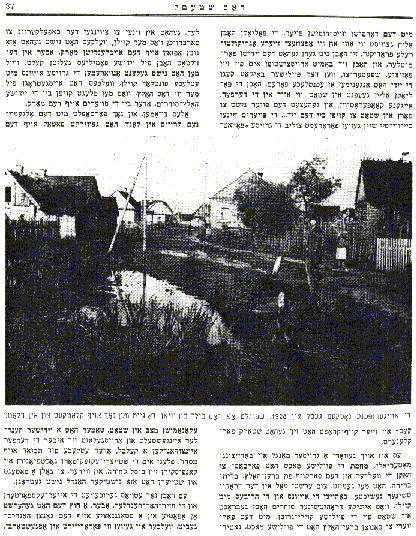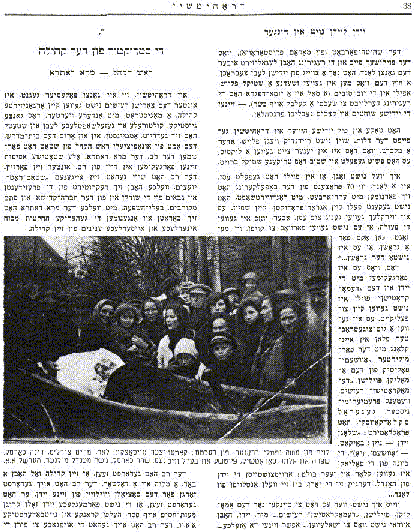Previous Page
|
Next Page
 [
Page 37
]
[
Page 37
]
with village White Russian peasants. The Poles knew how and when to market
their agricultural produce. They weren't fond of the Jewish middleman, and
thereby pushed him out of his position. Later on, when the Polish boycott
against the Jews came out in the open, the Poles went ahead and set up their
own cooperatives in town and in the villages, and incited the peasants to
refrain from buying from Jews. The peasants, were in any event already
impoverished by the high taxes, and their purchasing power was greatly reduced.
A shortage in heating material
also developed because the Polish authorities prohibited cutting down trees and
the sale of firewood. For the first time in the history of Drohitchin, people
were forced to heat their ovens with coal that a few Drohitchin merchants
brought to town from the Polish coalmines. With the ban on firewood, the Polish
authorities naturally forced the populace to use as much coal as possible,
since coal wasn't selling very well in foreign markets. However, as a result,
many Jewish families suffered from the cold because it was impossible to heat
large ovens with just a few pounds of coal that amounted to a great deal more
that wood, which was bought from Jewish wood merchants or peasants at the
market.
[Photo:] A so-called marshland alley in 1928 reflects the picture of the Vion.
This street goes over footbridges and marshes.
Everything together was made
even worse by the social problems in the country, which proved fatal to the
economic situation in the town. If a Jewish trader took a chance to do business
in the villages with a calf or a few pud of grain, a tax collector would follow
him and confiscate his bit of merchandise. In addition, such a poor businessman
was unable to pay for a tax or a license.
The egg exporters and pig hair
traders still had something to sell. Apart from that, however, there was apathy
and stagnation in the whole business sector, which was becoming increasingly
paralyzed and depressed.
 [
Page 38
]
[
Page 38
]
Jews suffer from hardship and hunger
The ban on kosher animal slaughter (thanks to Madame Pristorova), which the
Polish parliament legislated throughout the country, broke another branch of
Jewish life. In addition to the fact that people longed for a bit of meat, the
Jewish butchers and slaughterers were left without a livelihood (once in a
while the government would authorize slaughtering a small calf).
Many Jewish homes in Drohitchin
became impoverished. Never mind the absence of meat or clothing, which was
considered a luxury, people didn't even have a piece of dry bread to eat. I
don't want to say that there was nothing to eat in Poland. In a country where
70 percent of the population was involved in agriculture, it wasn't possible to
there not to be food. There was actually enough to eat, but there wasn't money
to buy it. As they saying goes: " An axle for a penny, but no penny to buy
it with." What happened to the Jews in "democratic" Poland was
no accident. It was a well-conceived plan and agreement with the a formulated
"social" policy of the Polish "democratic" regime, whose
prime minister, General Skladowski, proclaimed, "Hit Jews – No!
Boycott – Yes!" The intention of the policy was clear and obvious: to
get the Jews out of business, until they would eventually leave the country.
I don't know why anyone would
be nostalgic about the former Polish "democratic" regime. We Jews
certainly have nothing to be nostalgic about, but maybe there are a few…..
[Photo:] Funeral of Moshe Naftali Bronner. From right: Kaminitzer (Wisotsky),
Leah, Miriam Tsirel's, Dina Kharsal, Shifra and Alter Saratschik, Feitshe and
Berl Vichnes, Sarah Kharsal, Moshe Milner, Hershel, et al.
4.
THE STRUCTURE OF THE COMMUNITY
Head of the Community – Community Rabbi
In Drohitchin, just as
everywhere in the Polesia area, there was no organized community structure,
i.e. a "city hall," under the Czarist regime. The entire
intellectual, cultural and social life in the shtetl centered in and around the
House of Study. The rabbi served in the unofficial position of community head
in the shtetl. All community meetings took place at his home, with him serving
as chairman. The rabbi had his own "city council," and advisors, who
were recruited from the heads and treasurers of the synagogues and burial
society, as well as ordinary disciples and people of influence, with whom the
community rabbi discussed and decided on relevant internal and external
decisions of his community.
The rabbi was responsible for
making sure that his community had a public bath, a ritual bath and a doctor.
The rabbi was also responsible for the social well being of his Jews, and had
to make sure that the poor Jews received money for Passover matzah flour,
medical and other social assistance that they required. The rabbi was also
responsible for
Previous Page
|
Next Page
This material is made available by JewishGen, Inc.
and the Yizkor Book Project for the purpose of
fulfilling our
mission of disseminating information about the Holocaust and
destroyed Jewish communities.
This material may not be copied,
sold or bartered without JewishGen, Inc.'s permission. Rights may be
reserved by the copyright holder.
JewishGen, Inc. makes no representations regarding the accuracy of
the translation. The reader may wish to refer to the original material
for verification.
JewishGen is not responsible for inaccuracies or omissions in the original work and cannot rewrite or edit the text to correct inaccuracies and/or omissions.
Our mission is to produce a translation of the original work and we cannot verify the accuracy of statements or alter facts cited.
 Drogichin, Belarus
Drogichin, Belarus
 Yizkor Book Project
Yizkor Book Project
 JewishGen Home Page
JewishGen Home Page
Yizkor Book Director, Lance Ackerfeld
This web page created by Lance Ackerfeld
Copyright © 1999-2025 by JewishGen, Inc.
Updated 7 Dec 2001 by LA
 [
Page 37
]
[
Page 37
]



